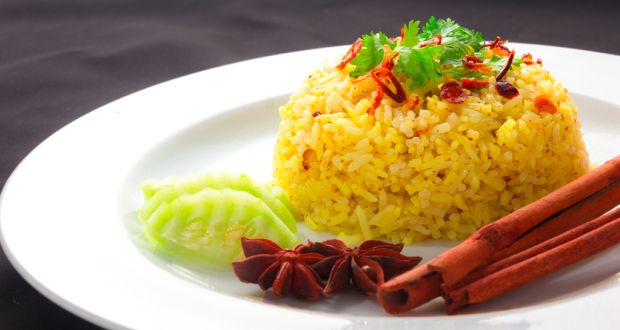On 4th of November, A great feat was achieved on; India made Guinness world record by preparing 918 Kg of Khichdi at a three day World Food India 2017 Event.
When you talk about Khichdi, the first thing that comes to mind is that someone is unwell, “Bimaro Wala Khana”. There is much more to Khichdi than just food for the unwell.
Khichdi is easily digestible and full of nutrition. This dish in many variations is made and loved spanning from east to west and north to south in our country. Khichdi also became unofficially national dish of India.
Here are 7 unknown facts about the most talked dish.
1. The oldest dish: Khichdi is one of the oldest known Indian dish, as we can find traces of Khichdi as Krusaranna in Kamika Agama, around the 2nd-century text. Also, the dish is mentioned in 13 Th century Moroccan traveler, Ibn Battuta’s diary as khishri made with rice and mung beans. And then again in 15th-century writings of a Russian adventurer, Afanasiy Nikitin, talks about Khichdi.
2. A Favorite of Mughals: we all have heard the story of Birbal and his Khichdi, certainly this dish was a favorite in Emperor Akbar and his son Jahangir. In the 16th-century text Ain-i-Akbari or otherwise known as Constitution of Akbar written by his vizier, Abu’l-Fazl ibn Mubarak. The recipe says that Khichdi (Khichdi) was made from mung dal, rice, salt, and ghee.
3. From the Agamas: Kamika Agama a second-century text in its chapter 6 verse 30 – 59 talks about various dishes and methods of preparation and offering to gods. Krusaranna is said to be evolved to today’s Khichdi, Krusaranna was prepared with sesame seeds, mung beans, salt, and black pepper and a certain quantity of rice. There are two more variations mentioned in the chapter. Cooked rice mixed with mung beans is called Mudganna and cooked rice, pepper, turmeric powder, cumin, and mustard seeds are used to prepare a dish known as Haridranna. These are three possible variations of Khichdi as mentioned in the agama.
4. Makar Sankranti connection: – Makar Sankranti is a day of celebration for many. Sun enters Makara Rashi or Capricorn. Marking the end of winter solstice and beginning of summer. This festival is celebrated in many ways. In some regions of India, people make a certain kind of Khichdi with Udad dal. If we analyze the Khichdi the connection, the lord of Capricorn is Saturn, and the sun entering Saturn’s its sworn enemy’s sign can be troublesome. For most Sankranti period marks beginning of harvest. According to Lal Kitab, Saturn is pleased with urad dal, therefore out of many remedies for Saturn’s malefic effects some say that one should either donate urad dal or food made with urad dal in charity. Therefore we can see eating of Udad Dal Khichdi can be a part of pleasing Saturn so that the harvest goes well, and there are no obstacles in a harvest.
5. A Monks favorite: Monks rely on alms, they go door to door and seek alms and manage with whatever they get. It is during medieval times monks used to travel and camp places. They used to go door to door and seek alms; mostly they would manage with some amount of Rice and Dal. Sometimes if lucky they would get some vegetables or spices. With whatever they would get in alms they would add everything to a pot and cook. This also marked the beginning of Khichdi. This Khichdi was a sole meal for any monk, be it Buddhist, Hindu Sadhu, Jain monks, Sufi saints, etc. Monks played a significant role in spreading Khichdi across the country, today every part of country Khichdi is cooked in their own style.
6. Detox Diet– Khichdi as per Ayurveda is used for detoxifying and cleansing of the body. Khichdi is said to be a dish that balances all three doshas – cough, pita, vaat. In Ayurveda, it is believed that health starts in the digestive system. The function of the whole system is dependent on the proper digestion, assimilation, and elimination of food; if this system is not proper then one may be vulnerable to disease. The digestive energy is called Agni, this fire must be strong and so beyond just cleansing the body, here Khichdi will rekindle Agni in the body and help in balancing the entire system.
7. Unity in diversity– Is a dish that whole India cooks; it is also popular in Nepal and Pakistan. The dish is made in many variants in coastal Maharashtra it is made with prawns. In Bengal, the dish is considered a rich gourmet delicacy and is loved in the monsoons. It is a staple for holy ceremonies and as an offering to Gods. In Bihar, It is customary to eat Khichdi every Saturday, and also at dinner during Makar Sankranti. In Gujarat and especially Kutch region Khichari is the traditional diet and a daily meal. in rural Haryana, kichri is made from bajra and mung dal. Odisha has many varieties of Khichdi; out of many Adahengu Khechidi is a popular dish in the Puri Jagannath Temple. Karnataka and Tamil Nadu have their own variants, Bisi Bele bath, and Pongal respectively. Khichdi also has an important place in Hyderabadi cuisine; Khichdi here is called “Khichdi, Kheema, and Khatta”.

Amazing